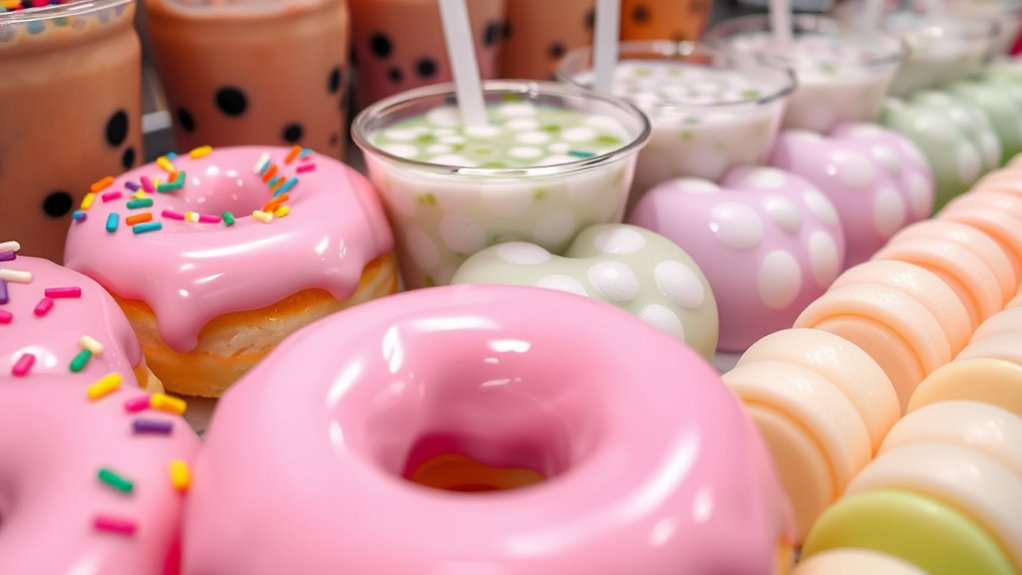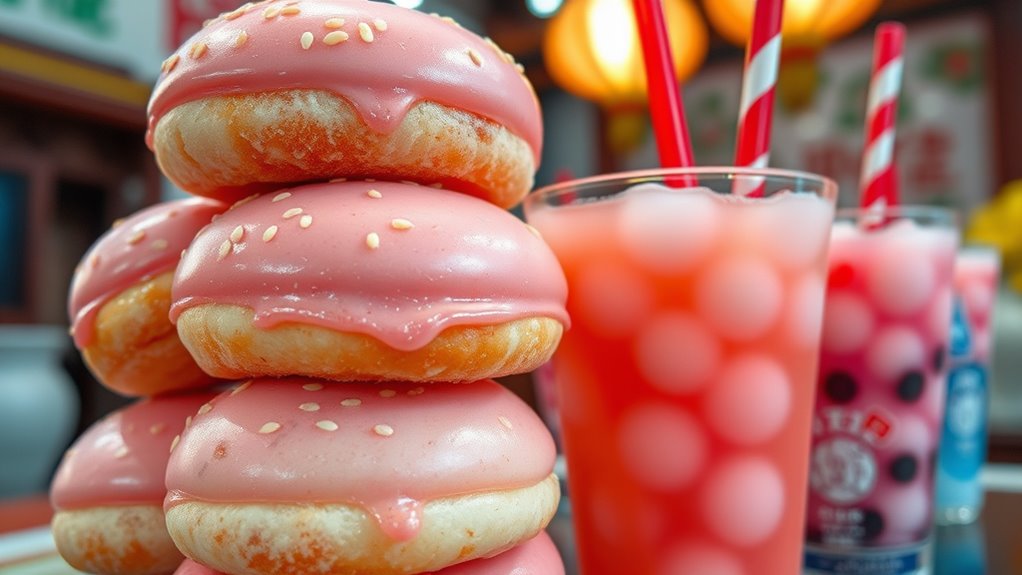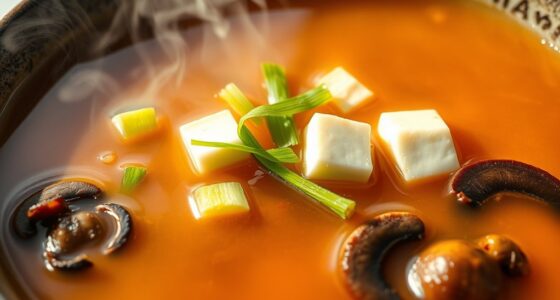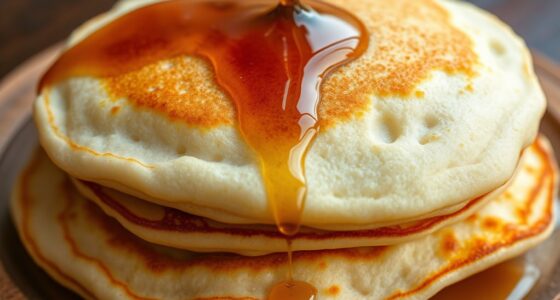The Asian sweets craze is sweeping globally, and you’ll find favorites like mochi donuts and boba drinks everywhere. Mochi donuts blend chewy rice cakes with crispy textures, often topped with colorful glazes, while boba treats add fun, chewy tapioca pearls to your drinks and desserts. These treats showcase vibrant flavors, creative fusion, and street snack roots. If you keep exploring, you’ll discover how these sweets are transforming dessert culture and inspiring new innovations around the world.
Key Takeaways
- Asian sweets like mochi donuts and boba treats have gained global popularity through street culture and gourmet innovation.
- Fusion desserts blend traditional Asian ingredients with Western styles, creating vibrant, unique flavors and textures.
- Mochi donuts combine chewy rice cake techniques with crispy donut shapes, often topped with colorful glazes and toppings.
- Boba drinks, originating in Taiwan, have expanded into desserts like ice creams and milkshakes, with customizable flavors and chewy tapioca pearls.
- The Asian sweets craze reflects culinary globalization, transforming street snacks into sophisticated, culturally rich desserts worldwide.

Have you noticed how Asian sweets are taking over dessert menus worldwide? It’s like a wave of vibrant flavors and innovative ideas crashing into the traditional dessert scene. One of the reasons behind this surge is the rise of fusion desserts, which blend Asian ingredients and techniques with Western favorites. These treats often start as street snacks, rooted in street snack culture where vendors serve quick, flavorful bites to passersby. Now, these same snacks are gaining popularity far beyond their origins, transforming into gourmet desserts that appeal to a global audience.
Asian street snack roots are transforming into trendy, global desserts with vibrant flavors and innovative fusion twists.
Take mochi donuts, for example. They’re a perfect example of fusion desserts that combine Japanese mochi rice cake techniques with classic donut shapes. Their chewy texture, combined with a crispy exterior, offers a sensory experience that’s both familiar and novel. You’ll find them coated in colorful glazes and sprinkled with toppings like matcha, sesame, or fruity crumbles, making them visually irresistible. These donuts have become a street snack that’s now elevated to a trendy dessert, often found in cafes and specialty shops. They embody the street snack culture—portable, satisfying, and made to be enjoyed on the go—yet they also appeal to those seeking a more refined, Instagram-worthy presentation.
Boba treats, another pillar of the Asian sweets craze, exemplify how street snack culture influences the modern dessert scene. Boba, or bubble tea, originated as a casual street-side drink in Taiwan but has since exploded into a worldwide phenomenon. Its chewy tapioca pearls add a playful texture that keeps people coming back. Today, you see boba incorporated into everything from ice creams to milkshakes, transforming it into a versatile dessert component. These drinks and desserts often feature layers of flavors—think fruity, floral, or even spicy—that showcase the creativity of Asian street snack vendors. They’re portable, customizable, and perfect for a quick refreshment or a full-on dessert experience.
What’s exciting is how these street snack roots continue to influence dessert innovation. Fusion desserts combine familiar Western sweets with Asian ingredients like matcha, red bean, or black sesame, creating a cross-cultural culinary conversation. This blending pushes the boundaries of traditional desserts, making them more dynamic and accessible. Incorporating authentic natural materials such as rice, tea leaves, and beans enhances the flavor profile and authenticity of these treats. Whether you’re biting into a mochi donut or sipping on a boba latte, you’re experiencing the evolution of street snack culture into sophisticated, globally loved treats. Asian sweets aren’t just a trend—they’re reshaping how we think about desserts, turning everyday snacks into occasions worth celebrating.
Frequently Asked Questions
What Are the Origins of Mochi Donuts?
You might be surprised to learn that mochi donuts originated in Japan, blending traditional techniques with modern fusion flavors. They combine the chewy texture of mochi rice cake with the shape and frying method of classic donuts. This innovative fusion creates a unique treat that’s gained popularity worldwide. By maintaining traditional techniques while experimenting with new flavors, mochi donuts offer a delightful balance of cultural heritage and contemporary creativity.
How Are Authentic Boba Pearls Made?
You make authentic boba pearls by cooking tapioca starch with boiling water until it forms a dough. Then, you roll it into small balls, often adding traditional ingredients like caramel or brown sugar for flavor. After boiling, you let the pearls cool in syrup to achieve the chewy texture. These pearls are used in bubble tea, where you can enjoy a variety of bubble tea flavors with high-quality, traditionally sourced ingredients.
Are Asian Sweets Suitable for People With Allergies?
Asian sweets can be suitable for people with allergies if you check ingredients carefully. Look for gluten-free options or treats made without nuts if you have nut allergies. Many vendors now offer allergy-friendly choices, but always ask about cross-contamination and ingredient specifics. By doing so, you can enjoy these delicious sweets safely while avoiding potential allergens.
What Are Popular Regional Variations of Mochi?
Imagine traveling through Japan, Korea, and China, each offering unique mochi flavors. You’ll find Japan’s matcha and red bean varieties, Korea’s sweet rice cakes with sesame, and China’s glutinous rice desserts infused with lotus seed or osmanthus. These regional variations reflect distinct flavor profiles and traditional preparation methods. You get a delicious glimpse of local culture in every bite, making mochi a versatile treat that adapts beautifully across Asia.
How Long Do Asian Sweets Typically Stay Fresh?
Asian sweets usually stay fresh for 1-3 days when stored properly. You should keep mochi and similar treats in an airtight container at room temperature or refrigerated for longer storage. Watch for spoilage indicators like mold, off smells, or sliminess, which mean they’re no longer safe to eat. For ideal freshness, consume them within this timeframe and avoid exposing them to heat or moisture.
Conclusion
As you indulge in these vibrant Asian sweets, remember they’re more than just treats—they’re gateways to a rich cultural tapestry. Each bite symbolizes a bridge connecting tradition and innovation, tradition and modernity. Let the colorful mochi donuts and bubbly boba drinks remind you that every culture’s sweetness adds flavor to our shared world. Embrace this craze, and let it inspire you to discover even more delicious stories waiting to be savored.









